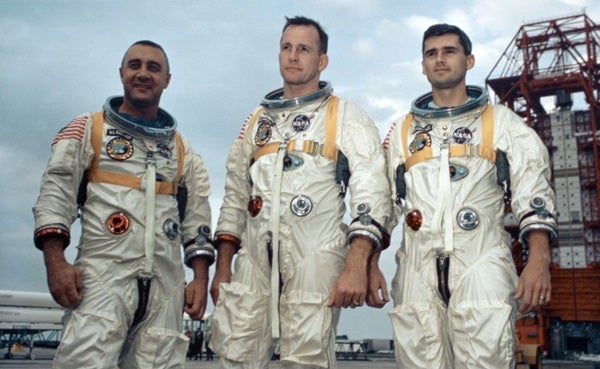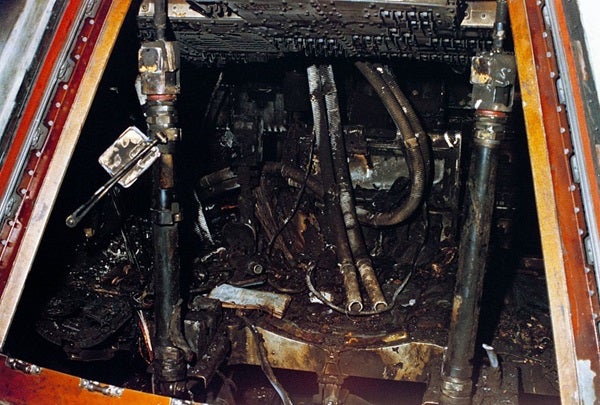Every January, a tight-knit clutch of families and friends head for a barren, disused area of Cape Canaveral to reflect and remember. With almost religious reverence, they lay bright splashes of winter blooms near a gaunt concrete and steel hulk that memorializes one of the darkest days of America’s space past. The structure, slowly but surely decaying in the salty Florida air, is now overgrown by weeds and wild pepper trees. Clinging to one of its rusting limbs is a faded “abandon in place” notice.
Three engraved granite benches furnish their own voiceless words of tribute. “Launch Complex 34, Friday 27 January 1967, 1831 Hours,” one laconically reads. Another recalls the three astronauts who died on this spot more than a half-century ago. These three American sons — Gus Grissom, Ed White, and Roger Chaffee — were lost in appalling circumstances, yet their sacrifice helped facilitate the success of the Apollo program’s push to land men on the Moon.
An uninspiring spacecraft
Apollo 1’s crew knew their ship could never reach the Moon. It was never meant to. The barebones ‘Block 1’ spacecraft, intended only for Earth-orbital tests, had none of the navigational wizardry or docking tools necessary for a lunar voyage. (Those flights would await the more advanced Block 2.) But from the start, many astronauts disliked and distrusted Block 1 for its faulty wiring, bad software, leaky valves, and dozens of unresolved technical problems.
Prime contractor North American Aviation was roundly blamed for poor workmanship and lax safety standards. “A slick, bigtime bunch of Washington operators,” astronaut Tom Stafford cynically opined in his memoir, We Have Capture (Smithsonian Books, 2004), “compared to the mom-and-pop operation at McDonnell,” which built NASA’s earlier Gemini spacecraft. During Gemini, astronauts could talk to the boss, James McDonnell himself, but North American was a very different corporate beast.
Yet North American faced its own challenges, notably NASA’s mandate that the Apollo capsule should possess a pure oxygen atmosphere. This choice was less technically challenging than arranging an Earth-like oxygen/nitrogen mix, but it posed an extreme fire risk. Anything in the spacecraft that accidentally caught ablaze would explosively burn — truly a devil’s bargain.
Backdropped by this palpable sense of unease, 1967 dawned. Commander Virgil ‘Gus’ Grissom, America’s second man in space, was joined on Apollo 1 by Senior Pilot Ed White, the nation’s first spacewalker. Rounding out the Apollo 1 crew was Pilot Roger Chaffee, an energetic rookie. The plan was that they would fly a 15-story Saturn IB rocket into Earth orbit in late February for a two-week shakedown of Apollo’s myriad systems.
But Grissom harbored scant faith in his ship, branding its design sloppy and unsafe. Even the simulators never marched in lockstep with ever-changing software and hardware modifications to the spacecraft. His crew had a mocking portrait taken, their heads bowed in prayer, hopeful that the space gods might conjure some happy fortune. “It’s not that we don’t trust you,” they told NASA brass, “but we’ve decided to go over your head.” When a journalist asked what would make Apollo 1 successful, Grissom unsmilingly retorted that getting his men home alive was enough.
The night before an unpowered (“plugs-out”) test of Apollo 1 that took place Jan. 27, 1967, fellow astronaut Wally Schirra pulled Grissom aside. He too hated the Block 1 design. “If you get the slightest glitch,” Schirra told his longtime friend, “get outta there. I don’t like it.”
The fatal fire
On the afternoon of Jan. 27, clad in their space suits, the crew boarded the Apollo 1 capsule, perched high atop the Saturn IB. Grissom noticed a strange odor, like soured buttermilk, but air samples revealed nothing untoward. The heavy, two-piece hatch was sealed, followed by the rocket’s boost protective cover. Next, pure oxygen was pumped into the cabin.
The hatch caused headaches of its own. North American wanted a single-piece hatch, fitted with explosive bolts so it could be quickly opened in an emergency. But NASA, fearful that the bolts could misfire while in space, nixed this idea. An inward-opening hatch meant cabin pressure would help tightly seal it during flight, but the design also made it hard to open when on the ground. During simulations, even the super-fit White needed two full minutes to crank the hatch ajar.
The test went badly from the outset. A high oxygen flow indicator repeatedly triggered Apollo 1’s master alarm, and spotty communications between Grissom and astronaut Stu Roosa, seated in the nearby blockhouse, caused tempers to fray. At one point, Grissom bellowed with unvarnished angst: “How are we gonna get to the Moon if we can’t talk between two or three buildings?”
Sitting with Roosa was astronaut Deke Slayton. Seconds after 6:31 p.m. EST, Slayton saw something odd on his monitor. It was an image from a camera pointed at Apollo 1’s circular hatch window. But instead of a dark circle, it was illuminated, almost white.
Suddenly, the crew’s biomedical readings skyrocketed, indicating increased oxygen flow in their space suits. Other sensors detected a brief power surge. Then came the first call from inside Apollo 1.
It was Chaffee’s voice. And it was just one word: “Fire!”
Now the calls came thick and fast. “We’ve got a fire in the cockpit,” Chaffee yelled. “Let’s get out. We’re burning up.” His transmission ended with a scream that was blood-curdling both in its brevity and its agony.
Downstairs, on the launch pad’s first floor, technician Gary Propst looked at his monitor and saw White, arms raised over his head, fiddling with the hatch. Propst wondered why he did not just open the hatch. But to do so, White needed a ratchet to release multiple bolts. With only seconds available before the fire and smoke claimed him, he scarcely had time to loosen the first bolt.
It made no difference. Fire hungrily gorged Apollo 1 as pressures sealed the hatch with immense force. No man on Earth could have opened it under such circumstances.
Would-be rescuers were beaten back by incessant waves of heat and what pad leader Don Babbitt called “a heavy thick grey smoke, very billowing, but very thick.” No one could see far beyond the end of their own nose. Twenty-seven technicians were treated that night for smoke inhalation. But the real horror came when rescuers reached Apollo 1, five minutes after Chaffee’s initial shout.
The command module, dimly lit by flickering flashlights, was a scene of devastation. Grissom, White and Chaffee were dead. None had suffered life-threatening burns, all having succumbed to asphyxiation.
Investigators found the fire likely sparked under Grissom’s left footrest, near some unprotected or chafed wires. Fed by pure oxygen, and with Velcro pads, nylon nets, and polyurethane panels adding extra fuel, an inferno took hold.
“At such pressure, and bathed by pure oxygen,” wrote Grissom’s biographer, Ray Boomhower, “a cigarette could be reduced to ashes in seconds.”
The lasting legacy of Apollo 1
‘The Fire,’ as history remembers it, came close to derailing America’s lunar goals. After Grissom and Chaffee were buried at Arlington, and White laid to rest at his beloved West Point, recriminations began. North American Aviation’s poor workmanship and NASA’s poor oversight were mauled by press, public, and lawmakers alike.
Over the next year, however, Apollo was reborn, a phoenix from the ashes. The spacecraft cabin was pressurized with a 60/40 oxygen/nitrogen mix; all flammable materials were removed; and a new single-piece hatch was installed that could be sprung open in seconds with a push from an astronaut’s pinkie.
Aluminum plumbing was replaced by stainless steel; coolant pipes were armored with high-strength epoxy; wire bundles were encased in metal. Nylon was replaced with fire-retardant Teflon and paper minimized, including reading material. “No books or magazines,” wrote Wally Schirra, who commanded Apollo 7 in October 1968. “Nor could we take anything made of paper to play with, such as cards or puzzles.”
The Apollo fire remains one of America’s darkest moments. It arose from an insatiable ‘go’ fever and the perverse prioritization of schedule over safety — a cruel lesson that would be repeated during the Challenger disaster Jan. 28, 1986, and the Columbia disaster Feb. 1, 2003.
But if a grain of optimism could be salvaged from Apollo 1, it is this: Without Grissom, White, and Chaffee’s sacrifice, it is highly improbable that America could have safely reached the Moon. And that, surely, is a legacy of which they can take pride.










